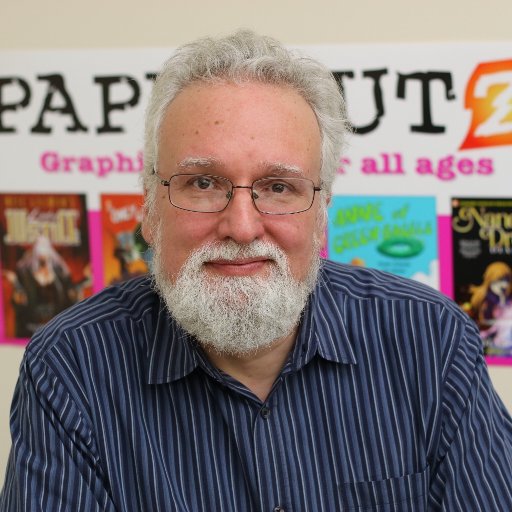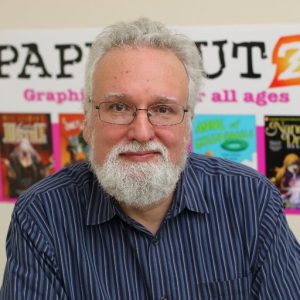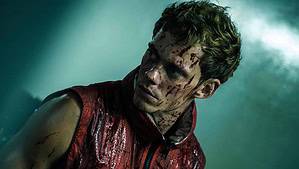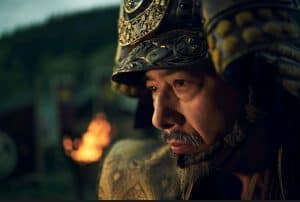As anyone who has read my posts in the past know, I am and probably always will be, a traditionalist. Especially when it comes to comics. Because of this, I was thrilled to have the opportunity recently to speak to a kindred spirit in Jim Salicrup. Jim was the Editor for Marvel Comics in the 80’s and he worked for them for 20 years. His remembrances of that time brought back such happy memories for me. It was a simpler time. When I hung on every word and image that Stan Lee and his mighty Marvel Bullpen produced. Many of my favorites including Spider-Man, The Uncanny X-Men, The Avengers, as well as my personal favorite the Fantastic Four were his responsibility. At the present, he’s Editor-in-Chief of PaperCutz, which produces and publishes graphic novels for all ages. (Note: This is a long interview, as might be expected for someone with Jim’s life experiences and insights.)
GVL: Thank you for sharing your time with us, Jim. So we’re going to start right from the beginning. We all have heard about people who at an early age who know what they want to do and took the steps to make it happen. This is Jim all over. With that in mind, please tell our readers exactly how it is you got started with Marvel?
Jim’s Start with Marvel
Jim: I don’t know if it’s necessarily the perfect way to start your life or career when you’re 13 years old but…what the heck. I chose to do something I loved and loved being around. So I’m not complaining. I’ll try to give you the short version, which is hard for me…but I’ll try anyway. This was back in the early seventies and I just remember that I wanted to get in print. This was before it was possible to be on the Internet or anything like that. So print was everything and I remember I tried to get fan letters published. When I discovered fanzines, I wanted to get involved with that and it was great. You know…the Junior High School newspaper… anything I could do get in print was incredible. That was even before I started at Marvel.
There was a magazine called Kids Magazine and I think it was founded and Co-Edited by Jenette Kahn who later became the president and Editor-in-Chief at DC Comics. The premise of the magazine was “for kids by kids.” All the contributors were under age 15. You send something in the mail and they might publish it. I sent some stuff in when I was 14 and wound up being called in when they moved to New York.
They were trying to get an issue out so they were rounding up all the kids who submitted work in the New York City area. I enjoyed working there and Jeanette liked my work which I was flattered by. However, there was another kid who I was a little jealous of. I felt he drew a little better than me and he wrote a little better than me. However, whenever we get together I like to tell him well, look, who’s the one who made it? Look who’s doing comic books. You had to settle for being the Co-Producer for Seinfeld and the Simpsons. His name was….
[Laughing] I think I blocked his name or something from my memory. But just becoming part of Kids magazine and seeing my work published, it was all very encouraging. We even did an interview with Bill Gates and Al Feldstein up in Mad magazine that never got published. But that’s a whole other story. Anyhow, I was encouraged greatly by all this. Especially when you consider that this was a kid who was growing up in the Bronx and who had lived in the projects. So to be in Manhattan, it was like a dream come true. After having read a lot of the fanzines and interviews with artists, I saw that a lot of them went to schools like music and art and art design. So I applied for art design and was accepted.
In addition, reading those interviews with artists, I noticed a lot of cartoonists got their initial breaks, being an assistant to a cartoonist. You know, cleaning the pinpoints, filling in the black areas, erasing pencils…that kind of thing and I thought I could do that. And so I did a postcard and I figured out a drawing of the Hulk in my imitation Herbe Trimpe style in color. One of my original lousy sketches, I guess and I sent it into the Marvel Editor-in-Chief Roy Thomas. This was the summer before I would be going to Art Design School in the summer of 72. It just happened to arrive at a time when the Marvel was expanding.
The Right Place, the Right Time
They were having all sorts of deadlines problems because they were expanding so much. As their production was increasing, they were falling far behind schedule. They couldn’t afford the luxury of sending the original artwork to the Comics Code through the mail anymore. At that time, they were hiring Messengers. Sol Brodsky was the guy who was keeping an eye on the bills and how much Marvel was spending on things. He quickly realized that it would probably be cheaper to hire a full-time minimum wage Messengers to deliver the comics to the Comics Code.
Rather than constantly, hiring a messenger each time. Roy Thomas, who was then the Editor-in-Chief, also recognized that Marvel was severely understaffed at that point. They were ramping up production and figured that no matter who they hired for any job, not necessarily related to editorial, it would make sense to hire people who knew something about Comics. That way they could lend a hand. That’s why they hired me instead of the stereotype of a messenger back then, who would have been some retired guy waiting in the reception room, smoking a cigar and waiting to deliver the next package.
Where as they could use me to do everything from cutting out the page numbers and taping them onto the bottom of the pages and even those little strips that said continued after next page. I was one of the people taping those down on the comics and doing all that kind of stuff in addition to delivering the comics to the comics code…Etc.
Once I was in the halls of Mighty Marvel, I was like a pit bull. I bit into Marvel and I didn’t let go for 20 years. I had the opportunity and I tried my best to figure out how to do it. And it was just wonderful. I mean again the contrast for me was.. it was like being a mere mortal who had somehow been taken to Asgard every day. I was surrounded by my personal comic book Gods. There was Roy Thomas, Stan Lee, John Romita, Sr., Herbe Trimpe, Marie Severin and many more. It was just unbelievable. I loved every second of it. I couldn’t wait to get into the office every day. Every morning was like waking up on Christmas.
The Mighty Marvel ”No-Prize”
GVL: As you talk about this all I’m thinking is I’m so jealous. When I was a kid, that’s all I wanted to do. I wanted to be an artist. I didn’t care if it was Marvel or DC. I’d draw for anybody but of course, living in South Haven, Michigan…there wasn’t a whole lot of ways to go about doing that. Now I did send letters to them just like you said. I wanted to see if I could get in the letters section in the comic. My goal was to be awarded the famous Marvel No-Prize. I wanted that No-Prize. I knew they weren’t anything but I wanted one. (In fact they were just an empty envelope like below…I still wanted it.)
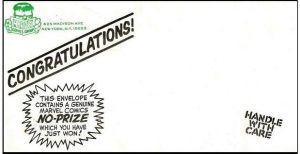
A Mighty Marvel “No-Prize”
Jim: Whenever I’m occasionally in New York City, there’s sort of a Comics community and we see a lot of each other at different events all the time. One guy, who is barely active in that is Art Spiegleman who won the Pulitzer Prize. I just figured well that’s good for him. But I won a “No Prize.” A Mighty Marvel “No Prize.”
GVL: Right! Which is much more prestigious if you ask me.
Jim: I know. There you go… It’s Great.
Jim’s Ambitions at Marvel
GVL: As you started working for Marvel, I imagine you were willing to learn anything they could teach you. But when you went in, did you want to be an artist? Did you want to be a writer? What did you have in mind?
Jim: I can tell you now, that when I went into this, I was probably naïve…some might say stupid. But it was probably just being young, I guess. But instead of thinking…here I am surrounded by potentially some of the best teachers in comics, with Romita and Marie Severin and Herb Trimpe, etc. But…My brain just sort of looked at it like…Oh my God. I wish I could…but I just can’t. I’m not worthy! I could never be as good as these people. I was just so humbled by it. It was just one of those things. Throughout school and even when I was at Kid’s Magazine…you kind of take it for granted. Just because you’re one of the kids who likes to draw you sort of fall into the…”well, he’s the best artist in school…he’s the best artist in the class.” Even at Kids magazine. And as I said I was jealous of Mr. Gammill [Tom Gammill…Jim remembered]. You know, at least I still thought I was maybe the second best. Jeanette liked my work so I was happy there.
Surrounded by Greatness
But then suddenly when I was in comics, I was surrounded by these guys. First off I should note… that I think my my own style is probably a lot cartoonier [than Marvel was looking for]. Marvel at that point, was the traditional Adventure superhero art style. Which I am really not that great at. I loved all the artists from Neal Adams, Jack Kirby, John Buscema, Romita…on and on. I loved all their work, but I think my talent naturally is a much more simplistic and cartoony. But back then, I just thought… I’m no good I guess. I can’t do what their doing.
But I loved this world so much…so I was like the “Little Mermaid,” I wanted to be a part of it. So I slowly worked my way up. Before computers, things had to literally be pasted down– they used rubber cement which was how we would do production work and you learn about lettering. In addition, Marvel was starting to develop a reprint of their comics in black and white in England. They developed a British Department in the New York office where they would do that. It would be photostats of the original comics and different people would do production work on it pasting it on to boards. Since the comics were originally created for color, gray tones were added by cutting out Zipitones and applying it.
Artists such as Edge Hannigan and Klaus Jansen started out doing that kind of stuff as well at Marvel. Pablo Marcos was there and Sol Brodsky headed up that department. So there were lots of things you could do. By Marvel fortunately being understaffed, there were lots of opportunities. They were expanding so rapidly that they would joke that almost anyone who could hold a pencil was welcomed in the door.
John Romita’s Warning
So it led to a lot of people getting opportunities and I tried to make the most of it. I was very fortunate and they were very patient and tolerant of me. Although on my very first day, I have to admit I was a little scared at first when John Romita, Sr. told me: “ Hey, Kid! You have a fallback career?” He was telling me that comics likely wouldn’t last much longer. It was a dying industry. Which is not exactly what you want to hear when you want to invest your life to something.
But in many ways, he was correct. I mean while comics do still exist today, it’s a different world in many aspects. There aren’t these inexpensive comic books distributed to newsstands everywhere. They are no longer found in candy stores, drugstore and 7-Elevens with the “Hey Kids” comics displays. It really was the tail end of comics truly being a mass medium. Now, it’s more of a hobby item in some sense. But you know, its transformed into something like graphic novels which are available in book stores, which are another thing [book stores]that might be dying out even as we speak. But I don’t want to be too pessimistic.
Comics have also wound up online. There are web comics which is something that would have been unbelievable when I was a kid. The fact that you could get your comics, or a collected edition, trade paperbacks, and graphic novels in a library. That was like unthinkable. Even School libraries…they used to take your comic books away if you were caught reading them in school. Now you can go to the school library. They encourage you to read comics.
GVL: Where do you think they GOT all their comics from? From all the kids they took them from when they were not allowed to read them.
Jim: [Laughs] Well, if they have them, they can solve a lot of problems by selling them as back issues.
Learning it All
GVL: The reason I brought the subject up was as I was looking over some information about you, it looked like you’ve done a little bit of everything. I’ve saw where you’ve tried your hand at pencils, you’ve done some inking. You’ve also have been credited with coloring, writing and of course, editing. I mean, so it looks like you kind of got your hand into every pot.
Jim: If they had let me at the printing plant, I would have done that too. It’s just something I enjoyed every aspect of it. Even when I was a kid. There was a kid who lived across the street from me named Stefan Petruka who’s done lots of writing for me at Topps Comics and now at PaperCutz. When we were kids, we were trying to do comics together.
We met at a place a couple blocks from where we both lived called Dave’s Variety shop. He would buy comics from kids for two cents each and then sell them for a nickel. There were lots of old Marvel back issues that Stefan and I were using every spare penny we had, buying up as many as we could. So we got to meet each other as we had this love of comics. It wasn’t wasn’t long before we were trying to make comics ourselves with him writing and me drawing.
Choosing to be an Editor
GVL: So who was it who first suggested to you the idea of becoming an editor?
Jim: I think I gradually eased into it. Because one of the things I enjoy is being around people, and working together. They did have staff artists, writers and all that. But generally in the office, in the Marvel editorial offices, you would fall into categories. Mostly editorial or production or Art Director, that kind of thing. So, I did a bit of production, but editorial was interesting to me because it just seemed like the the ultimate comic book fans dream job. You could have an idea and pass it onto the writer and they would do all the hard work. They would be in a room by themselves, coming up with the story and you get to be the guy who says well, I don’t know maybe it should be a little bit like this.
Generally I work with writers who I have a lot of confidence in and do a great job on it. And then even the art side of me, I love working on the covers. Being a comic book editor you have to be part Art Director as well. You’re art directing the interior pages as well as the covers. I love the covers. Because of that, I would sometimes do my own little lousy sketch of an idea and it was wonderful to see what a real artist would do. I mean, I would do these I did sketches and people from John Romita, Jack Kirby and John Byrne wound up doing the the actual artwork and it was like, WOW!
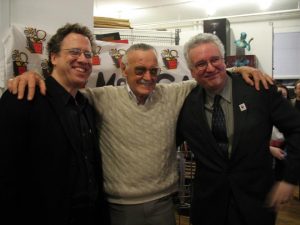
Danny Fingeroth, Stan Lee, and Jim Salicrup
GVL: I think I told you this when I first contacted you. They will drum me out of the geek leagues if I don’t ask about Stan Lee.
Jim: [ laughs] What do you want to know?
Meeting Stan Lee
GVL: Well, how about when did you first meet Stan?
Jim: I think In terms of actually meeting him, it probably would be that summer of 72 when I started at Marvel. He was this larger-than-life figure who would breeze in and out of the office. I think the day I was hired, his secretary may have turned in her resignation that day. He was a fairly demanding boss and but it’s only because he was such a hard worker himself. He expected the same from everyone else. That personality that you see at conventions and interviews and movies…that’s exactly who he was. He was amazing, fantastic, incredible etc. and was just a lot of fun to be around. Because he was smart, he wanted to surround himself with the best talent possible to create the best comics possible. It was very inspiring and I was very fortunate to know him for 46 years.
This is from the perspective of someone who was a comics fan who sort of idolized him. But when you actually work with someone, they do become human. I always found that some people react by saying. “Oh, you shouldn’t Meet Your Heroes.” But one of the reasons he was my hero, was his whole approach to the Marvel Universe compared to back in the 60s.
You had the DC Comics, now they weren’t called universes back then, but the DC characters were very much authority figures. They were sort of coming out of the 50s where they wanted the superheroes to be as good as possible and the villains were bad as possible. I think Marvel’s approach, Stan’s approach, was to make them as human as possible.
Heroes weren’t perfect, their lives didn’t go perfectly well. Spider-Man could still have trouble paying his bills, things would go wrong. He’d risk his life to defeat a super villain and the media, probably J. Jonah Jameson who was the best example of fake news, would write about it and blame Spider-Man. He was risking his life to save everyone else and then he was portrayed as the villain. I loved that about Marvel because as I was growing up, my view of the world was much closer to the Marvel world than the one DC Comics was presenting.
I wouldn’t mind if the world was like Metropolis, where there was this guy who would fly down to get a cat out of a tree and we were all safe. But, I was living in New York and so were the Marvel Super Heroes and it really was as crazy as they were portraying it. Not necessarily with superheroes and villains but, I would hear government people say one thing and I would look around me and I see the opposite. There was a war on poverty yet I saw the poverty. I felt like this this was something more believable to me.
The Human Side of Stan Lee
So the fact that Stan himself was a human being. None of us are perfect. I had no problem with that. I think overall he was a great person. His good qualities far away outweighed his minor flaws. It was just a dream come true, not only to work for Marvel but to be friends with Stan and to learn from him. I was sort of like in a ringside seat. I got to see him in action and and learn from him. It’s something that I think I’m going to continue to do for the rest of my life.

Stan Lee
GVL: If there was one thing…and this is probably an impossible question to answer… if there was one thing that you think that Stan taught you that might be most personal or the most important to you, What do you think that might be?
Jim: Well in regards to creating comics… When people ask me, “What does an Editor do?” I try to preface my answer by saying that everyone makes the job their own, and they like to have their own way of doing it. I was inspired by Stan and I feel this comes from him. When I explain what I tried to do as an editor, it was to create an environment that’s conducive to creativity.
I think in real terms what that meant in regards to Stan, was that when Marvel was starting in the 50s, they were a big company turning out dozens of titles every month. But that sort of came to an end in the late 50s and it was down to just a few titles. It was almost over. That’s when they decided to remap and come out with some superhero titles. They were, at that point, a fairly tiny Company, limited by their distributor to how many titles that could publish. They just didn’t have the economic resources, of a bigger company.
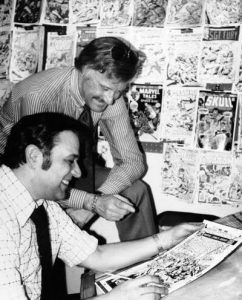
Stan Lee and John Romita, Sr.
They couldn’t pay as high a page rate as the money that Freelancers were getting. So, how do you attract Talent? How do you compete under those kind of circumstances? I think a big part of it was just being able to see the opportunities when they would present themselves. So if a Jack Kirby or Steve Ditko, Don Haggard, Dick Ayers, or a Stan Goldberg or any of those people were available. I think Stan knew how to work with them in such a way that he could get the very best out of them.
And I think a lot of that is, if you contrasted his approach to what was the prevailing editorial approach back in the day. You could hear hear a lot of horror stories from old Comics Pros about cigar-chomping comic book editors who just treated it as some kind of job. The artist would come in, turn in their pages, get their check and pick up the next script and that was it. The only thing that mattered was meeting the deadline.
Whereas Stan’s approach, and this was genuine with him. I would go to Comic book signings with him. He’d be doing autograph sessions and people would bring various Marvel Comics for him to sign. There would be long lines for Stan to sign this stuff and this happened almost every time. Stan would be trying to give each fan a moment and be as friendly and cordial as possible. He would give them his attention while still trying to keep the line moving. But, every now and then, he’d be distracted by one of the comics they were presenting to him. You could see…he would look at it and he would turn to you and say [in Stan Lee’s voice] “Wow! I can’t believe what a great job John Buscema did on this page!”

Stan Lee
That was a big part of it. [His appreciation of the artists]. You know, people like Jack Kirby, and Steve Ditko and the rest were incredibly talented. It was a very weird occupation especially back then. Kirby would work in his basement, Ditko in his studio etc. They would be by themselves and they be drawing away and to put any kind of effort into it or imagination and to just turn it in and have someone give you the check. Well, obviously that was very important to everyone because they had families to support or they had to survive and pay their bills, but it was it was totally different with Stan.
The Marvel Method
He would, being sort of a frustrated cartoonist himself and certainly a very talented art director, appreciate great work. He was not shy about telling the artist what a great job they were doing. I think they loved that and they responded to that. He knew they were very talented. He wanted to keep them happy and he wanted to keep them busy. And so almost out of a combination of necessity and of wanting to get the best out of his talent and keep them busy, the whole Marvel method evolved.
Stan realized he had very talented storytellers in Jack Kirby and Steve Ditko. For them to have to wait around until he typed up another script that probably wouldn’t be as good as what they could come up with, evolved into his system. Which is, “Let’s talk it out. Let me give you an outline. Let me give you the plot and you could go improvise.” This was something actually unheard of in comics at that point and these were the perfect guys for it.
Later on, whatever bitterness they have expressed years later, I spoke to who knew them at the time and they were very excited about it. I think Ditko was probably a little bit more sensitive and he went through period towards the end there where he wasn’t even talking to Stan. I would hear stories from John Romita or Frank Giacoia and others, about driving back to Long Island with Stan and Jack in the car, discussing and arguing storylines and working.
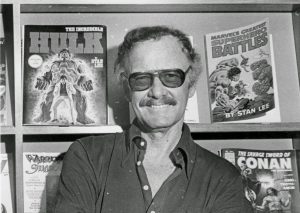
Stan Lee
I think Stan was encouraging and challenging his creators to do work that they can enjoy and be proud of. Whenever they brought pages into the office. This continued for many years with all the other artists, Gene Colan, Romita, Herbe Trimpe, Marie Severin and George Tuska, etc. It was something that I think they were having fun. Maybe they weren’t making as much money as they could at some of the bigger outfits, but I think they enjoyed that experience. They enjoyed bringing in the work and having someone genuinely appreciate it. He understood what they were trying to do and guided them in a particular direction. I think they enjoyed that they were getting some sort of recognition for all the hours they were putting into the work.
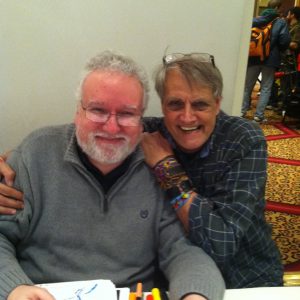
Jim Salicrup and Herb Trimpe
Conversely, when those relationships would sour, and some of the Artists might become bitter and just figure, “I’ve had it. Stan hurt my feelings. I’m just gonna knock it out.” However, some of those artists were so talented that their idea of “knocking it out” were still producing work far better than so many others in the field.
GVL: I have to admit every time you keep going through these list of artists, all I keep doing is smiling because I know them all. Trimpe, Romita, Kirby, Buscema and all the others. Like you, these people were God to me. I also understand what you’re saying [about appreciation]. The place that I used to work, the manager there’s belief was that if he were to compliment you on what you did, you’d be satisfied and you’d just stop working. I however, was just the opposite. I wanted you to recognize what I’m doing and then I’ll work harder for you. But if you don’t recognize what I’m doing that I’m thinking well, why am I bothering?
Recognizing the Work
Jim: Right! Exactly! It’s just a matter of how you’re being treated. For example, there may have been other editors who followed Stan who took maybe a harder line. They could actually be right with what they’re saying. But we’re human and we have emotions. Sometimes, and I’ll speak for just myself, if someone is yelling at me, my response initially is rarely: “Oh, he has a very good point. I think I made a mistake there. I should listen to his advice.” But instead, the reaction is more primal. It’s like: “I hate this guy! I just want to punch him in the nose! [laughs] But I can’t…because he’s my boss.”
So I found, that the extra effort that Stan took to try to win the artist over, to create this environment that was conducive to creativity is a very real thing. It works on many levels and it is almost extends outside of the world of comics. It’s all about how you interact with people in general. So many people, would have these encounters with Stan Lee at a convention or wherever and they would walk away feeling like, “What a great guy! I really enjoyed meeting him. He was so nice, etc.” and I’m not saying he’s not. Because, I truly believe he is.
Stan’s Positive Inspiration
I think what he was good at and what he inspired in me and I think many others is just an approach to life. An approach where we appreciate what’s good. We see people and we accept them and love them for who they are. Not expecting perfection. But, by accepting them, flaws and all, assuming that they’re not overwhelmingly horrible people. In that case, it’s probably best not to associate with that person anyway.
But Stan just wanted to communicate in such a way where he made everyone feel good. He made being a part of Marvel feel special. It was one of those things that he handled it in such a way. Where on one hand, it was this over-the-top humor, where everything was exaggerated beyond belief as a joke. But at the same time, there was a real warmth and love behind it. So he was willing to make fun of himself and everyone else in the characters. I think it created for the creators, not only an environment that they enjoyed being a part of but also for the fans who read Marvel Comics back then when Stan was in charge of it.
They enjoyed that environment as well. The readers enjoyed the time they spent with the Marvel characters. It was meaningful. They said they loved the characters. They were like their friends and they loved to be in the Marvel Universe. I think the people doing the movies understand that very well. Similarly, they are creating the same kind of environment.
I was Stan Lee’s Evil Clone
GVL: Since we are talking about Stan, as I was doing my research I ran across something. Tell me about “I was Stan Lee’s Evil Clone.”
Jim: [Laughs] Between my being the Editor in Chief at Topps Comics [where he went after leaving Marvel] and starting up PaperCutz, I was at a point where I didn’t know what to do. I was also helping start working with Lawrence Klein who was the founder of the Museum of Comic Art. So I got a call from Stan asking if I could come out to be a writer editor for Stan Lee Media. I was at Marvel for 20 years and it wasn’t an easy decision to leave. But you know, the Marvel I dreamed about working at was becoming less and less that as the years went on.
The first ten years, Stan was still there but then Stan moved to LA. Through various ways, I managed to stay in touch with him. For example, I was the Editor at Marvel Age [A Marvel Magazine] and there was a period there where the once unthinkable happened. They decided to drop Stan’s Soapbox from the bullpen bulletins page. I figured what the heck, and I decided to run Stan’s Soapbox in Marvel Age which I had been editing for about eight years. So every month, I was guaranteed I would have a phone call with Stan, just to discuss what he could write in his soapbox.
But anyway, I had gotten this call, but I was like I knew that PaperCutz would be starting up probably within a couple of years. My partner Terry had to set things in motion. He was already running one company and it was going to take a while to get everything in order for PaperCutz. So fortunately, I’ve been lucky and always had freelance work and what have you but this was a totally unexpected opportunity. The fact that Stan would call me and want me to come out to LA. I’ve been on pretty much a lifelong New Yorker. I don’t even know how to drive. However, I figured, OK… I could do this while I’m waiting for PaperCutz to be ready. I could come up to LA and then I could come back.
The Patience of Stan Lee
So when dealing with Stan, one of his many personal traits is he’s not one of the most patient people in the world. This has been very useful for him for many reasons. I think it’s one of the reasons he writes so fast. He just can’t wait to get it done. So he’s a very, very fast writer. So we called me on a Friday and expected me to start work on Monday in Los Angeles [laughs]. I told Stan, “Give me a give me a couple of weeks to get everything in order.” This was a major life change for me. I would have to figure out a way to work in Los Angeles for a while because I certainly wasn’t going to give up my New York apartment or anything like that. So in two weeks I figured I could do it. I remember thinking, I’m proud of myself, getting ready pretty much within a week and a half. This would add some extra days before I had to go out there.
So what happens? Sure enough, I wound up breaking my ankle. I had never had broken a bone in my body before. But after celebrating my upcoming trip to LA, I crossed the street and tripped over a manhole cover. I figured well, that’s that. In truth, when I left Marvel after 20 years, I pretty much felt that was the end. I probably was never going to be able to work with Stan again. And little did I realize when I worked at Topps, I would wind up working with Jack Kirby, Dick Ayers and Don Heck in the Kirbyverse… but that’s another story.
So I broke my ankle and I was figuring well, that’s not good. Stan was already impatient and was reluctant to give me the two weeks I needed to be able to get out there. However, I have to say, he was willing to hold the job for me. I tried I got out there as quickly as I could. Not only could I not drive, which seems to be a requirement to living in Los Angeles. I still don’t drive, by the way, but now I couldn’t walk. I was on crutches.
Over the years, since I was at Marvel, I’m was one of those kids who grew up loving comedy. It was yet another appeal of Marvel to me. The humorous aspects of all the characters and the fact that Marvel didn’t take itself all that seriously. But you know, I like doing impressions of my favorite comedians or actors, etc. Stan had such a distinctive way of speaking. It was impossible not to do an imitation of him.
Stan Lee Media
So anyway, Stan Lee Media which was a very interesting company in so many ways and I could go on forever about that, but I’ll spare you. He was developing new characters and properties that would appear not in comic books but online. He was really way ahead of the curve. This is when the majority of people were still using dial-up. So the idea of creating a ‘webisode,” where it would take a half hour to download a two minute cartoon shows he was a little too early. The concept was good and Stan truly was ahead of his time at that point.
But I was hired to do everything that wasn’t the Webisodes. Columns, silly articles, puzzles…things like that. One thing I remember writing, which was totally silly, was the Stan Lee Trivia Quiz. I’ll share a couple of my favorites. Everyday there would be a different question. The majority of them would be stuff most Marvel fans would be able to answer. Stuff about things Stan wrote and created at Marvel.
However, I would love taking the name of it literally in that it was the “Stan Lee Trivia Quiz.” So I had one question about was what Stan Lee’s shoe size. I believe it was 9 ½ in case you were wondering. My absolute favorite was “What did Stan have for lunch today?” So I asked him, “What did you have for lunch today? His answer was bottled water and some crackers and cheese. So I put that down as the answer. However, he he would edit everything I would do, before it would go up on the site. I remember he changed it to two hot dogs and a Pepsi. It’s almost like Stan Lee was a character and he was very aware about the need of creating his image with the public.
Stan 2.0
So at one point one of the other characters he created for the website was Stan 2.0 or Stan Lee’s Evil Clone. He had wrote the first few and he did the voice for it. But at this point in time, he was involved in running around the world to get investors for the company or create new deals. Because of that, he didn’t have as much time to write it and do the voice.
A daily website requires a lot. It is constantly hungry for new material and he wasn’t there so that wasn’t going to happen. Obviously, they can get other people to write it. They have a staff of writers and that fell onto me. They were talking with some of the producers and production people, and they knew we had to hire an actor to do Stan’s voice. Some of the people in that production meeting, (I was told this, I wasn’t in that production meeting) said, “Wait a minute. Jim does an imitation of Stan. Why don’t we get Jim to do it?”
Now this was a very surreal experience for me because I was interested, but I had to do an audition for Stan. Over all the years, I’ve been very careful to make sure I never did it [his impression] when Stan was within earshot. I didn’t know how he’d take it. But let’s just say I got the job and it was very surreal. The truth is I don’t really sound like Stan. He has a great voice but I could talk like him. Besides, this was a clone anyway, so it wasn’t really Stan and he was an evil clone besides. They would do all sorts of weird effects with the sound and all sorts of beeps and noises.
It was a very weird thing. However, the fun part of writing it, and leave it to Stan even though I was calling it “his evil clone, he didn’t want it to truly be evil. He could poke fun, but if we were talking about celebrities or something he didn’t want me to say anything that would offend anybody. What if we want that celebrity to work for us? We don’t want to upset them. Okay, that’s a challenge. I’ll do an evil characters. Who’s Not evil.
It was fun doing the evil clone because, as I said, there was a very public side of Stan which was a huge emphasis on being positive. I think he got a little crankier in his later years in the public. But in the office, everything I said earlier was true. However, as I said, he was human and he might get upset. Not necessarily directed at me but at others. When I would do the voice for the evil clone it was that Stan who I was channeling. He wouldn’t blaspheme like I’m about to do now, but you know, it was not uncommon when Stan would get upset over something here he might go: [in Stan’s voice] “Jesus Christ! What the Hell Happened here?! Who threw THIS up?!!”
Editing Kraven’s Last Hunt
GVL: That was great. Ever since the Avengers: End Game ended up, everyone on Geek Vibes have been talking about which possible characters or stories might be introduced, especially with Spider-Man. One of the characters that is mentioned a lot is Kraven the Hunter. The story they mention most is Kraven’s Last Hunt. As luck turns out, YOU were the Editor for Kraven’s Last Hunt. In addition, you were way ahead of your time when you made it go across different Spider-Man issues, the first cross-over. I mean “crossover” wasn’t even a thing then but you were the first to do it. So tell me a little bit what went into making Kraven’s Last Hunt?

Kraven’s Last Hunt, Part One
Jim: I have to give credit where credit’s due. The actual series started when J.M. DeMatteis came up with the story. I think originally as a Batman story and then he wasn’t able to sell it. I think he reworked it for maybe a couple of other characters. You could double-check with him. (We are scheduled for an interview with Mr. DeMatteis in July) I think perhaps Daredevil at some point. I’m not sure. He finally pitched it to the Spider-Man editors of the time, Tom DeFalco and Jim Owsley and they they loved it. They approved it and it was finally underway. I followed Owsley as Spider-Man editor. And so I think maybe the first two were already drawn and written when I came on.
I looked it over didn’t really make too many changes. The biggest one was to let Mark know that Spider-Man, by the time we would run the story, would be married to Mary Jane (Jim also was the Editor of the famous Spider-Man/Mary Jane Wedding issue.) He did a lot of reworking of his own script who to make it fit into continuity that way. I think he was very happy about it and felt it helped strengthen the story considerably.
One of the first Crossovers
As for the crossover aspect of it. I was, as if you could tell, a very old-school Marvel fan. One of the things that I felt was great about the early 60s Marvel Comics was pretty much most of the characters just appeared in their one monthly comic book title. The exceptions would be something like maybe Nick Fury, who appeared in comics during World War II and the present one as the head of Shield in the early 60s.
There were attempts to try to use characters in more than one title. The Human Torch had his own feature in Strange Tales. The early first 14 or so issues of The Avengers were more like the Justice League with the big stars. Eventually Captain America would appear in Adventures and in the Comic strip. But for the most part, if you were interested Spider-Man, that’s really the only comic you needed to read. One issue would lead right into the next and I liked that.
When Marvel was expanding during the early 70s which was around the time I came on, it was a tricky situation. They had a new owner, Cadence Industries that obviously saw the potential of comics and wanted Marvel to be as big as possible. That meant producing more and more titles. At that point, Marvel didn’t see itself as just hero characters, they wanted to do everything. They wanted to do all they possibly could. They did knockoffs of everything else that was being done, you know, If Mad and Cracked were doing well, Marvel came out with crazy. If Warren was doing well, Marvel came out with black and white horror titles.
Now they got into sword and sorcery with Conan and there were movie tie-ins with Planet of the Apes and 2001, anything at all. There was humor, there was westerns, horror, you name it. Kung Fu, anything that seemed like it might be popular, Marvel will try to do comics based on it. And I loved that aspect of it. You know, I love superheroes, but I think after certain amount per month, it just becomes unwieldy. It’s like who could possibly read all of them? For example, I remember when I was at Marvel editing Spider-Man and it was a a company-wide crossover. It was called Inferno.
Inferno
And I thought well, this is a great opportunity for the Spider-Man titles because I was very competitive. I wanted Spider-Man to be the top selling title and be able to get a little bit of the X-Men audience. I felt for that two month period we’re going to pull out all the stops and try to make our crossover issues as good as possible. But make people who were possibly picking it up because it was an Inferno crossover would end up enjoying it because it was a Spider-Man story.
That was a lot of fun to do but in my heart of hearts, the numerous titles were too much. I think I understood the pressure the editors and everyone were under in to keep creating more and more titles. Obviously, there were so many Marvel characters we would all love to see have their own title. But as that was happening not every character would be a big success. So they were sort of following DC’s example, where you take some of your top characters and spread them out over several titles. So something like Marvel team-up was created and then there was Spectacular Spider-Man, Web of Spider-Man, along with the Amazing Spider-Man, etc.
When is Many TOO Many
As a fan I just I just didn’t love that idea. In my opinion, it just diluted the character. So when I started editing the Spider-Man titles, I tried not to disparage what anyone had done before. Everyone has their own approach and their own reasons for doing things. There’s no hard right or wrong. It’s highly subjective. But in my opinion, it’s hard for me to accept Spider-Man as one character if one week, he’s like doing this stuff when he has this girlfriend. The next week he’s with a different girl from the previous week.
My compromise would have been if I had my way, there should just be The Amazing Spider-Man and if Marvel wanted three or four Spider-Man titles per month, let it be a weekly title. I mean, it makes so much sense to me. I understood when you had a successful title like the X-Men where you could spin out some of those characters. You could even create other groups of Mutants, but when it’s one guy you keep spreading them out over numerous titles. I just didn’t think it was a good idea. But if you could keep it one title on a weekly basis where one title would feed right into the next one. That to me seemed like the way to go. This is who he is and if something happens to him this week, you’ve got to wait till next week to see what happens next.
Bringing the Story Home
That opportunity came when Marvel was changing editors-in-chief and I sort of grabbed it. I figured well, I can’t get them to cancel these other titles, but with a storyline as powerful as Kraven’s Last Hunt, I could make it so each title tied in to the same story. Where one week, Spider-Man might be buried alive. The last thing I wanted to see was another comic book coming out in the next week with Spider-Man doing just fine and battling Doctor Octopus. The only explanation being a little footnote on page one saying well this takes place after the events of Kraven’s Last Hunt. It just didn’t make sense.
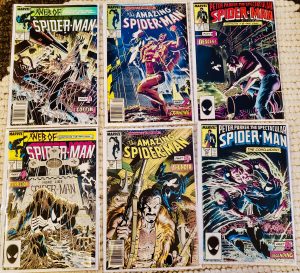
All Six Issues of Kraven’s Final Hunt
But everyone was used to this is as that was how it was done. And I just couldn’t wrap my head around it. So I saw the first opportunity I had with that particular story line. It just seemed to make sense and I felt it would work. The only complaints really were people who were just subscribers and maybe they subscribe to only one of the three Spider-Man titles. And so for them, it was unfortunate that they would get like just two parts of a six-part story. So I feel that’s a legitimate reason to be upset with what I did. Overall, however, I felt for the story to have maximum impact, it was to run it on a weekly basis. It must have worked to because here we are 30 over 30 years later. We’re still talking about it.
GVL: That’s because the fan’s are still talking about it. You must have done something right.
Jim: It appears so.
What these names mean to Jim
Okay. I got one more thing I want to do here. I want you to play a quick word association with me. I’m going to give you a name and just tell me the first couple things that come off your head for each of these names.
Roy Thomas:
He’s the best! I owe everything to him. He was the one who noticed my postcard way back in 1972. He not only hired me at Marvel, but also at Topps, he recommended me to Len Brown to be Editor-in-Chief of the Comics Department.
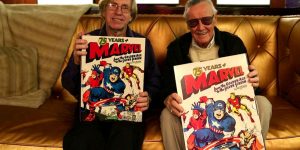
Roy Thomas and Stan Lee
Sol Brodsky:
Another surrogate father for me at Marvel. He was sort of Stan’s right hand man. He’s a true unsung comic book hero. I learned a lot from him. He was able to do all sorts of incredible things and was far more organized than I’ll ever be. Sol had the right attitude how to work with people and do a professional job. How he put up with me, I’ll never know.
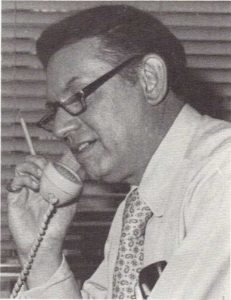
Sol Brodsky
Jim Shooter:
Another guy I learned and incredible amount from. Especially, since I’m doing comic books now for all ages at PaperCutz. So much Jim would explain to all his Editors, in terms of the basic elements of comic story telling has been invaluable to me. While you may not agree with someone 100% on every single thing, I always acknowledge Jim as being incredibly smart. I did my best to try to do things the way he liked to see it. It was a real educational experience for me and I’m so thankful. He gave me plenty of opportunities for which I’m truly grateful.
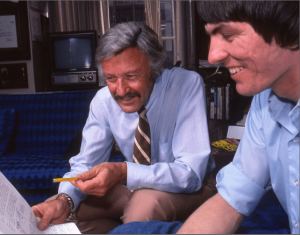
Stan Lee and Jim Shooter
Jack Kirby:
These were all legends to me and I still have to pinch myself that I got to work with them. As nice as everyone else was, he had to be the nicest one of all. Just an unbelievably kind and nice person. Super talented, you know. It was a thrill to be able to work with him. I’ll give you a quick story. We were launching the Kirby-verse at the San Diego Comic-Con and a bunch of us went out to dinner that night. And Jack was just being so kind and thanking me over and over again for publishing the Kirby-verse at Topps.
Finally, at some point, as much as I would never want to argue with Jack, I had to tell him to please stop thanking me. If anything, I should be thanking you. For what you, Stan and Steve did. You know this life I have this other career I have? Everything I’m doing is my feeble attempt to thank you in some small way for what you’ve meant to me in my life. Thank you Jack.

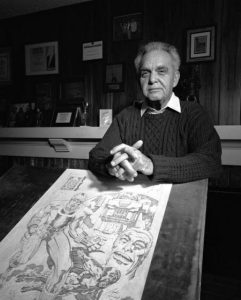
Jack Kirby and the Kirbyverse
Todd McFarlane:
He was an absolute thrill to work with. I’m still amazed at whatever he does. I still can’t wait to see his next Spawn movie, directed by him. He’s unbelievable. What I think would shock most people who are familiar with Todd McFarlane of today…I wish I could go back in time and record our first conversation regarding Spider-Man. Where I was so confident that we could compete against the X-Men and I was arguing with him. He didn’t think it was possible. He just didn’t think Spider-Man had the right type of stuff about characters that would appeal to the comic fans.
Because, everyone at that point was thinking, to be the top selling comic, it has to be like X-Men. Well, no X-Men has to be like X-men, Spider-Man could be like Spider-Man. My plan was just sort of emulating what had gone before in the 60s. I just wanted what I felt was crucial as to why the X-Men was successful. It had committed creators.
Chris Claremont up until that point was the X-Men writer. He was the voice of all those characters. They had just a couple of artists. Originally Dave Cockrum and then John Byrne. When I spoke to Todd early on, I felt and I was predicting, , that if he could just stick with the Amazing Spider-Man for seven years. I was confident we could topple the X-Men to become number one, but lo and behold we did it in less than three years. That was Todd McFarlane.
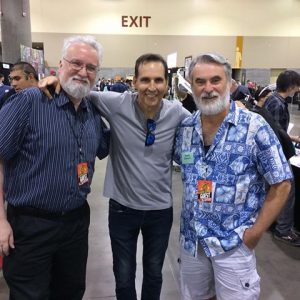
Jim Salicrup, Todd McFarlane, and Randy Emberlin
Stan Lee:
Stan is the ultimate inspiration for me…in so many ways. The fact that he wanted to elevate comics into something that everyone would be aware of and love and enjoy. Plus we got to see him do it and more importantly, HE got to see the incredible success at Marvel Comics and the characters he co-created within his lifetime. So much of the literal details of the Marvel movies, owe so much to Stan.
It’s the spirit of the characters, that the the movies managed to understand. You know it’s the humanity they gave to the characters. They followed Stan’s basic premise of trying to have these fantastic characters in a believable world. They made it fun, they made it dramatic, they made it over-the-top. In a sense, they made it Stan. As for me personally, I learned so much from him and he continues to inspire me literally.
What’s happening at PaperCutz
GVL: Well before I let you go and I really do appreciate all your time here. Do you have anything coming out from PaperCutz in the near future that you want the fans to know about?

Jim: Well, there are a few, but I’ll limit it to one. It’s actually the 2nd of a three book series and it’s called VINCENT BOOK TWO: HEARTBREAK AND PARTIES 101 by Vitor Cafaggi. It is a story where the characters are very much human, but they’re drawn as animals. Vincent is a dog, but he’s pretty much your classic comics fan. He plays role playing games and is getting ready to go to college.
It is the 2nd of a three-volume series all about a coming of age. He’s discovering, women and having his first serious relationships with girls. You get to see how that all fits together with his nerdy friends and the role-playing gaming buddies. It’s wonderfully written and has a lot of heart and humor. It plays on that that whole sense of not taking ourselves too seriously. It’s a very interesting series and it’s worth trying. It’s called Vincent Book Two from Super Genius. Until it is released, they can check out VINCENT BOOK ONE: GUIDE TO LOVE, MAGIC, AND RPG, which is the first book in the series.
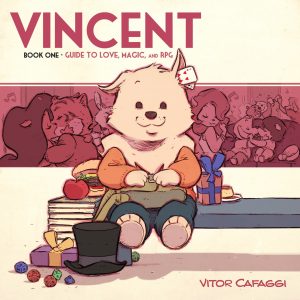
GVL: And is that something they can go to the website to get?
Jim: I mean you could probably get the best prices on Amazon. But if you can get your local comic shop to order it for you, then you should do that because we should all support our local comic shop.
GVL: Are there any conventions happening in the future where fans can catch up with you?
Jim: I’ll be at the Florida SuperCon during the Fourth of July weekend. I’ll be down there.
GVL: If you get the chance, you should stop by and talk to Jim and all the comic book creators. They are really nice people and you will not regret it. All right, then Jim I really appreciate all your time. You’ve been fantastic and I will hope to get you back on again sometime.
Jim: Well thanks for having me. You’ve been very patient and kind. Although, you kind of lied to me a bit [Laughing]. You told me there would not be any questions I hadn’t heard. You did ask some things that were different.
GVL: Well that’s a good thing. We’ll hopefully talk to you again, soon.
We hope you enjoyed our interview with Jim Salicrup. He’s a fascinating man, especially for those of into the glory days of Marvel. Share your thoughts about it and all thing’s Marvel with us at GVNation. Be sure to check out PaperCutz and all they have to offer with Graphic Novels for all ages. Also stay tuned for our exclusive interview with Comic Artist Paris Cullins, coming soon to GVN.
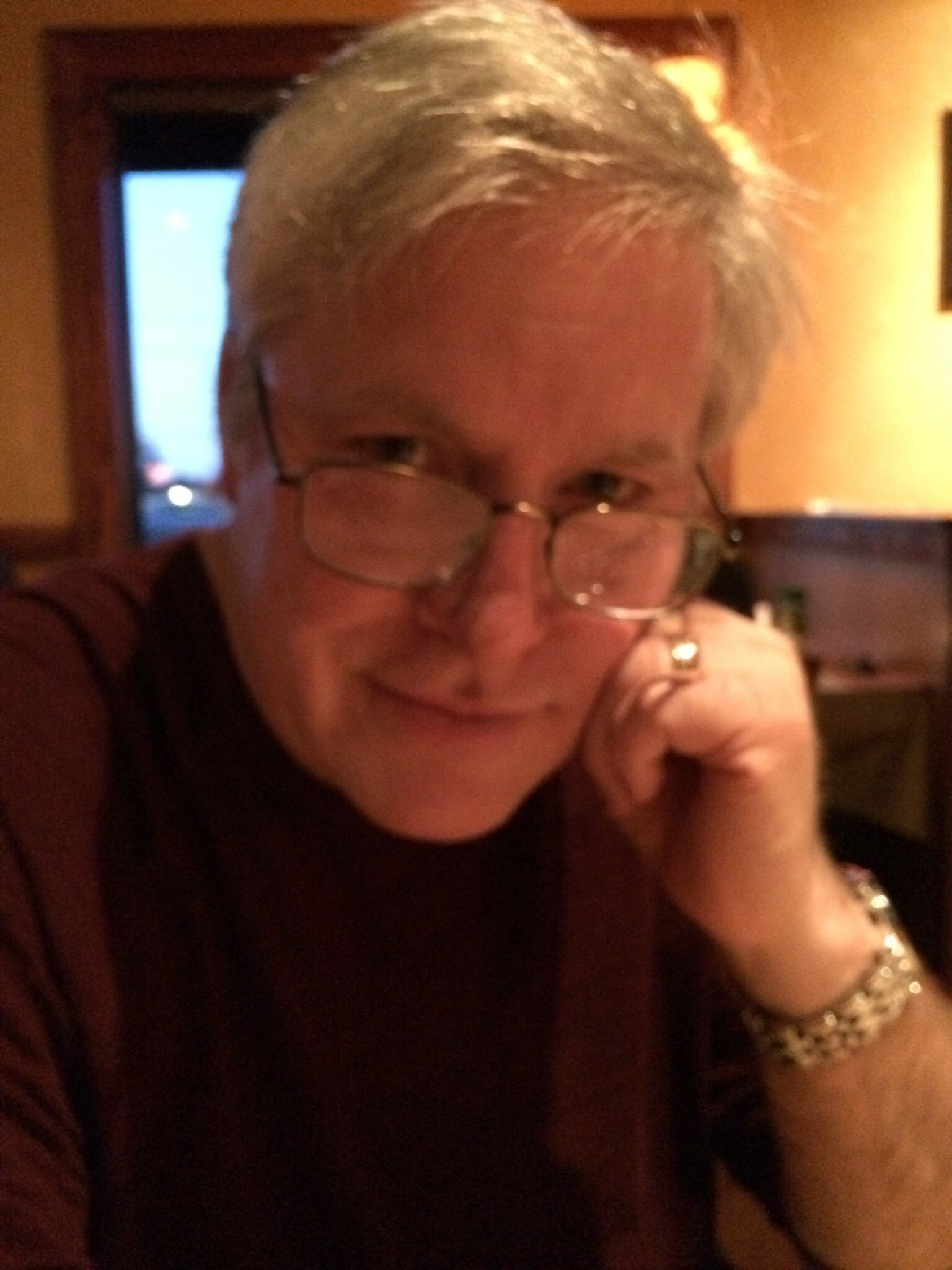
Senior Writer at GeekVibesNation – I am a 50 something child of the 70’s who admits to being a Star Trek/Star Wars/Comic Book junkie who once dove head first over a cliff (Ok, it was a small hill) to try to rescue his Fantastic Four comic from a watery grave. I am married to a lovely woman who is as crazy as I am and the proud parent of a 18 year old boy with autism. My wife and son are my real heroes.


